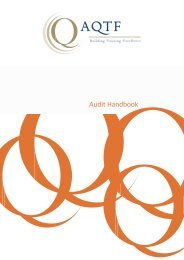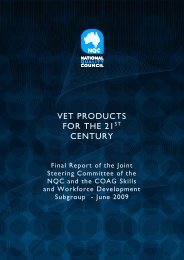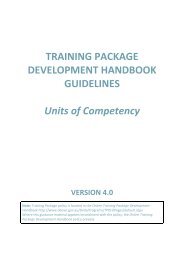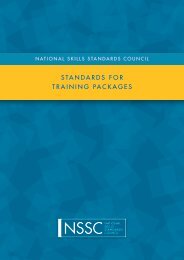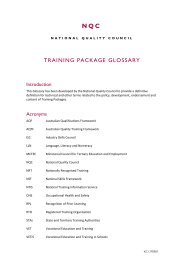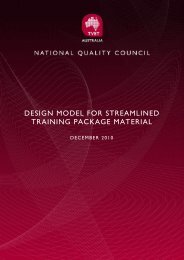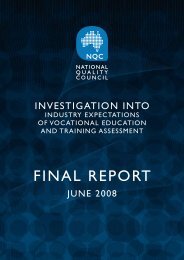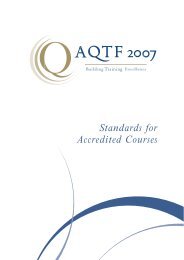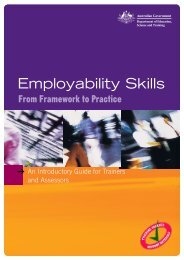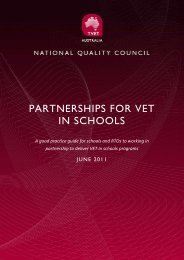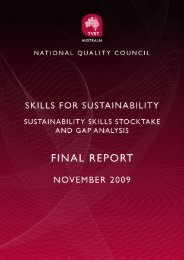Guide for Developing Assessment Tools - National Skills Standards ...
Guide for Developing Assessment Tools - National Skills Standards ...
Guide for Developing Assessment Tools - National Skills Standards ...
- No tags were found...
Create successful ePaper yourself
Turn your PDF publications into a flip-book with our unique Google optimized e-Paper software.
NQC | <strong>Guide</strong> <strong>for</strong> developing assessment toolsper<strong>for</strong>mance on a task. It is concerned with the degree to which the evidence collectedcan be used to infer competence in the intended area, without being influenced by othernon-related factors (eg literacy levels).Content validityContinuous ImprovementCriterion referencingCurrencyDecision making rulesDe-identified samplesThe match between the required knowledge and skills specified in the competencystandards and the assessment tool’s capacity to collect such evidence.A planned and ongoing process that enables an RTO to systematically review andimprove its policies, procedures, services or products to generate better outcomes<strong>for</strong> clients and to meet changing needs. It allows the RTO to constantly review itsper<strong>for</strong>mance against the AQTF 2007 Essential <strong>Standards</strong> <strong>for</strong> Registration and toplan ongoing improvements. Continuous improvement involves collecting,analysing and acting on relevant in<strong>for</strong>mation from clients and other interestedparties, including the RTO’s staff.A means of interpreting candidate per<strong>for</strong>mance by making comparisons directlyagainst pre-established criteria that have been ordered along a developmentalcontinuum of proficiency.One of the rules of evidence. In assessment, currency relates to the age of theevidence presented by the candidate to demonstrate that they are still competent.Competency requires demonstration of current per<strong>for</strong>mance, so the evidence mustbe from either the present or the very recent past.The rules to be used to make judgements as to whether competency has been achieved(note that if grades or scores are also to be reported, the scoring rules should outline howper<strong>for</strong>mance is to be scored). Such rules should be specified <strong>for</strong> each assessment tool.There should also be rules <strong>for</strong> synthesising multiple sources of evidence to make overalljudgements of per<strong>for</strong>mance.This is a reversible process in which identifiers are removed and replaced by a code priorto the validation/moderation meeting. At the completion of the meeting, the codes can beused to link back to the original identifiers and identify the individual to whom the sampleof evidence relates.Face validityThe extent to which the assessment tasks reflect real work-based activities.FairnessFlexibilityHolistic rubricInternal consistencyInter-rater reliabilityIntra-rater reliabilityModerationOne of the principles of assessment. Fairness in assessment requires consideration ofthe individual candidate’s needs and characteristics, and any reasonable adjustmentsthat need to be applied to take account of them. It requires clear communication betweenthe assessor and the candidate to ensure that the candidate is fully in<strong>for</strong>med about,understands and is able to participate in, the assessment process, and agrees that theprocess is appropriate. It also includes an opportunity <strong>for</strong> the person being assessed tochallenge the result of the assessment and to be reassessed if necessary.One of the principles of assessment. To be flexible, assessment should reflect thecandidate’s needs; provide <strong>for</strong> recognition of competencies no matter how, whereor when they have been acquired; draw on a range of methods appropriate to thecontext, competency and the candidate; and support continuous competencydevelopment.A holistic rubric requires the assessor to consider the quality of evidence produced <strong>for</strong>each competency or learning area. The evidence produced <strong>for</strong> each competency isbalanced to yield a single determination or classification (i.e. competent or not yetcompetent) of the overall quality of the evidence produced by the candidate.A type of reliability which is concerned with how well the items of tasks act together toelicit a consistent type of response, usually on a test.A type of reliability which is concerned with determining the consistency of judgementacross different assessors using the same assessment task and procedure.A type of reliability which is concerned with determining the consistency of assessmentjudgements made by the same assessor. That is, the consistency of judgements acrosstime and location, and using the same assessment task administered by the sameassessor.Moderation is the process of bringing assessment judgements and standards intoalignment. It is a process that ensures the same standards are applied to all assessmentresults within the same Unit(s) of Competency. It is an active process in the sense thatadjustments to assessor judgements are made to overcome differences in the difficulty ofGUIDE FOR DEVELOPING ASSESSMENT TOOLS PAGE 25



